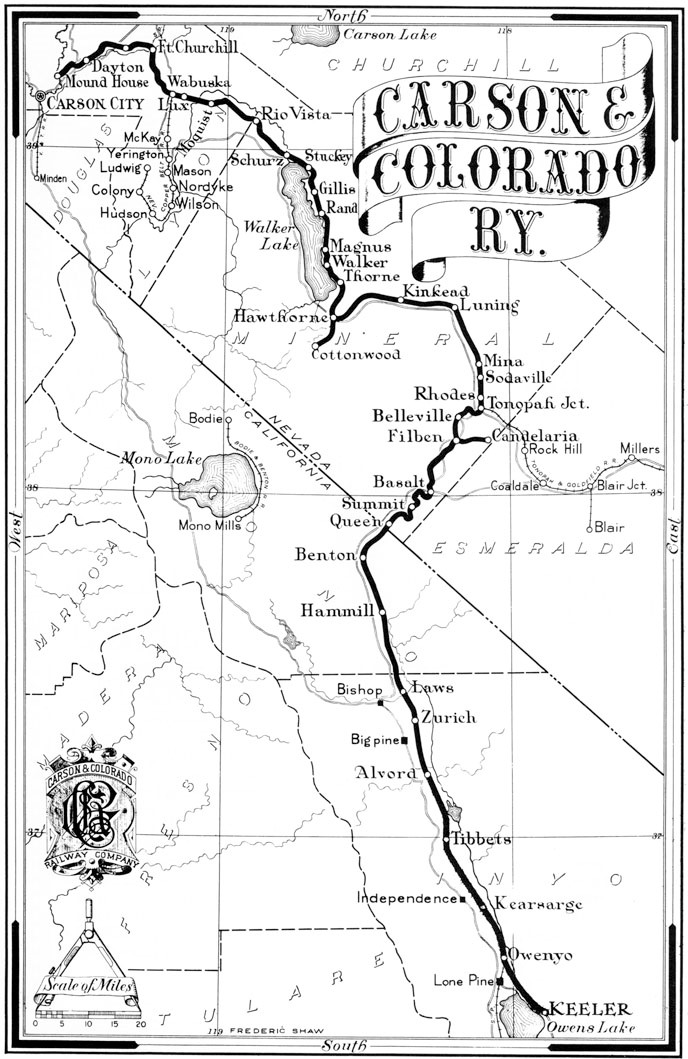Carson & Colorado Rail Road ( C&C)

- C&C Map.jpg (197.53 KiB) Viewed 753 times
• William Sharon, Hume Yerington VP & G. Superintendent, Darius Mills – controlled V&T
• The Carson and Colorado Railway was a U.S. narrow gauge railroad that ran from Mound House, Nevada, to Keeler, California below the Cerro Gordo Mines.
• It was incorporated on May 10, 1880 as the Carson and Colorado Railroad, and construction on the railroad began on May 31, 1880. A track gauge of 3 ft (914 mm) was chosen to reduce cost.
• Much of the route parallels U.S. Route 95 Alternate, U.S. Route 95, Nevada State Route 360 or U.S. Route 6
• The Carson & Colorado began operations with a single Baldwin 4-4-0, the Candelaria.
• The first train arrived at Keeler on August 1, 1883.
• The 300-mile route reached an altitude of 7100 feet in Montgomery Pass.[1]
• The railroad served an arid area heavily dependent on mineral resources for economic activity.
• The line was reorganized as the Carson and Colorado Railway in 1892 to reduce accumulated debt.[2]
• The Virginia and Truckee Railroad, the parent company of the C&C, sold the line to the Southern Pacific Company in 1900.
• Silver and gold discoveries at Tonopah, Nevada and Goldfield, Nevada provided a major boost of revenues shortly after the Southern Pacific purchase.[2]
• The northern 140 miles from Mound House to Mina, Nevada was standard-gauged in 1905; and the C&C was merged into the Southern Pacific's narrow-gauge subsidiary, the Nevada and California Railroad.[3]
• The Nevada and California Railroad was reorganized into the Central Pacific Railroad in 1912.[3] Portions of the line were abandoned in the 1930s and the 1940s, and the last narrow gauge common carrier made its final run on April 29, 1960.[4] The rails were removed in January, 1961. The former parent company, the V&T, is currently being reconstructed.
• Mound House grew in importance with the Comstock silver strike and the famed Virginia and Truckee Railroad passed through the community. It grew in population during the mining boom with a railroad station (1871) and post office (1877) as the center of the community. Upon construction of the Carson & Colorado (narrow gauge) Railroad in 1880, Mound House became and important multi-gauge transfer depot for both freight and passengers.
Carson & Colorado Stations
• Mound House, Nevada (V&T Railroad to Carson City and Virginia City)
• Dayton, Nevada
• Fort Churchill, Nevada
• Wabuska, Nevada (Copper Belt Railway to Yerington)
• Lux, Nevada
• Moquist, Nevada
• Rio Vista, Nevada
• Schurz, Nevada
• Stuckey, Nevada
• Gillis, Nevada
• Rand, Nevada
• Magnus, Nevada
• Walker, Nevada
• Thorne, Nevada
• Hawthorne, Nevada (branch to Cottonwood)
• Cottonwood, Nevada (branch only)
• Kinkead, Nevada
• Luning, Nevada
• Mina, Nevada
• Sodaville, Nevada
• Rhodes, Nevada
• Tonopah Junction, Nevada (Tonopah and Goldfield Railroad)
• Belleville, Nevada
• Filben, Nevada (spur to Candelaria)
• Candelaria, Nevada (spur only)
• Basalt, Nevada
• Summit, Nevada
• Queen, Nevada
• Benton, California
• Hammill, California
• Laws, California
• Zurich, California
• Monola, California (formerly Alvord)
• Aberdeen, California (formerly Tibbets)
• Kearsarge, California
• Manzanar, California
• Owenyo, California (Southern Pacific Railroad to Lone Pine, Ridgecrest, and Los Angeles)
• Alico, California
• Dolomite, California
• Mock, California
• Keeler, California[5][6]
Desert Magazine December 1948
Last Passenger Trip . . .
BISHOP—What may have been the final passenger trip in the history of the Carson and Colorado narrow gauge railroad was
taken by 100 members of the Pacific Coast chapter of the Railway and Locomotive historical society in October.
The trip over the remaining 72 miles of trackage, from Law to Keeler, was made on flatcars on which benches were provided.
Gilbert Kneiss, president of the society and author of Bonanza Railroads, told the story of the railroad from its construction in 1880 through the Tonopah and Goldfield mining rushes, and the final abandonment of most of the line.—Inyo Register.
Nevada's Longest line . . .
Desert:
Peggy Trego's December travel column, "Montgomery Pass," contains the following statement:
"Happily, the highway follows the narrow-gauge remnant of what was once Nevada's longest railroad—the Carson and Colorado—the line of the Slim Princess."
The Carson and Colorado between Mound House, Nevada, and Keeler, California, was 293 miles in length, of which 107 miles
were in California, leaving 186 in Nevada. This from timetable No. 15, effective Monday, October 15, 1883.
The records show that the Union Pacific has 288 miles of track across Nevada, the Western Pacific 428 miles, and the Southern Pacific 443 miles. Of course, the Union and Western Pacific lines are "Johnnie- Come-Latelies," having been constructed long after Carson and Colorado was built, but the Central Pacific, now a part of the Southern Pacific system, was in existence considerably before the Carson and Colorado was constructed.
From the above you can see why I question that the Carson and Colorado was once Nevada's longest railroad.
ARTHUR C. DAVIS
Reseda, California
(Of all the railroads planned, financed and built within Nevada—with that state as "home port"—the C&C was the longest. The transcontinental lines were never regarded as "Nevada's." They still aren't. Ask any Nevadan. Mrs. Trego considers 294 track miles (a figure that does not include the Filben to Candelaria spur) as the rightful claim of the C&C's total length. "Some highly interesting arguments," she writes, "can be set forth as to track mileage of various roads entirely within the state. Sen. William Clark's Las Vegas-Tonopah line had approximately 207 miles of rail." Borax Smith's Tonopah & Tidewater RR, running up from California's Mojave Desert into southern Nevada, might possibly be considered by some as being "Nevada's longest line."—Ed.)